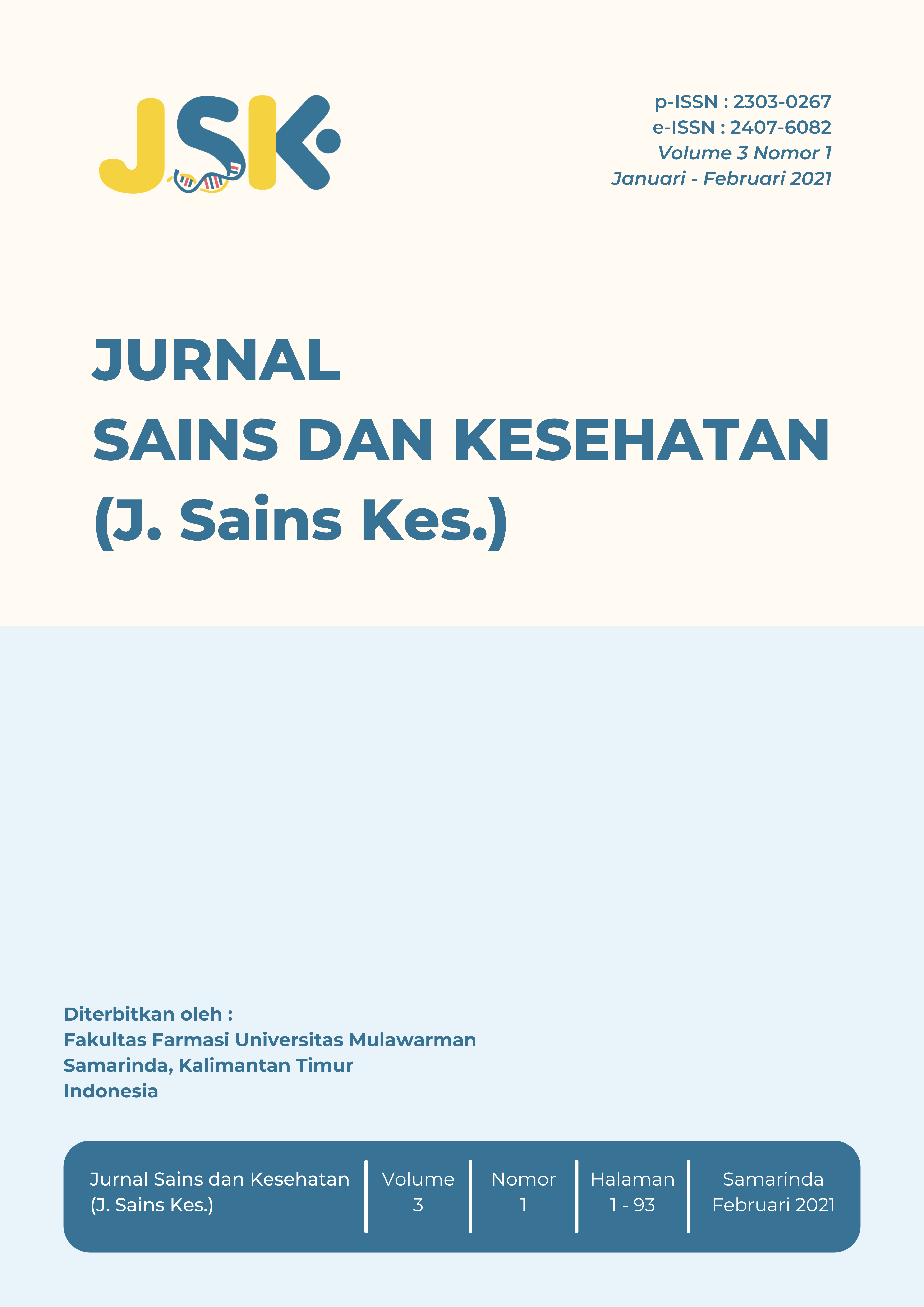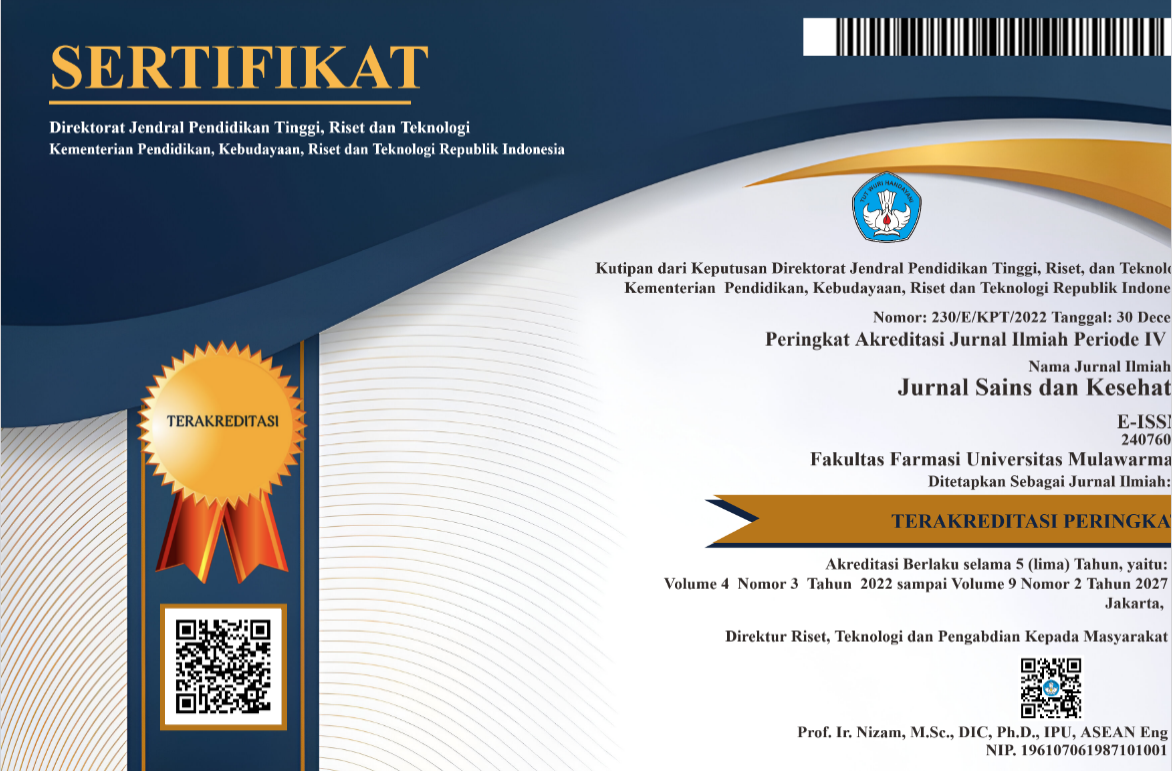Peningkatan Laju Disolusi Ketoprofen yang Diformulasikan dengan Metode Self Emulsifying Drug Delivery System (SEDDS)
Keywords:
Disolusi, etoprofen, Self-emulsifyng Drug Delivery System (SEDDS)Abstract
References
S. Kalepu and V. Nekkanti, “Insoluble drug delivery strategies?: review of recent advances and business prospects,” Acta Pharm. Sin. B, pp. 1–12, 2015, doi: 10.1016/j.apsb.2015.07.003.
K. T. Savjani, A. K. Gajjar, and J. K. Savjani, “Drug Solubility: Importance and Enhancement Techniques,” ISRN Pharm., vol. 2012, no. 100 mL, pp. 1–10, 2012, doi: 10.5402/2012/195727.
V. R. Vemula, V. Lagishetty, and S. Lingala, “Solubility enhancement techniques,” Int. J. Pharm. Sci. Rev. Res., vol. 5, no. 1, pp. 41–51, 2010.
R. Jagadeesan and M. Radhakrishnan, “Novel approaches in the preparation of solid dispersion on solubility: A review,” Int. J. Pharm. Pharm. Sci., vol. 5, no. 3, pp. 1000–1004, 2013.
P. S. Yadav, V. Kumar, U. P. Singh, H. R. Bhat, and B. Mazumder, “Physicochemical characterization and in vitro dissolution studies of solid dispersions of ketoprofen with PVP K30 and d-mannitol,” Saudi Pharm. J., vol. 21, no. 1, pp. 77–84, 2013, doi: 10.1016/j.jsps.2011.12.007.
J. J. Sheng, N. A. Kasim, R. Chandrasekharan, and G. L. Amidon, “Solubilization and dissolution of insoluble weak acid, ketoprofen: Effects of pH combined with surfactant,” Eur. J. Pharm. Sci., vol. 29, no. 3-4 SPEC. ISS., pp. 306–314, 2006, doi: 10.1016/j.ejps.2006.06.006.
D. Psimadas, P. Georgoulias, V. Valotassiou, and G. Loudos, “Molecular Nanomedicine Towards Cancer?:,” J. Pharm. Sci., vol. 101, no. 7, pp. 2271–2280, 2012, doi: 10.1002/jps.
N. K. Sachan, A. Bhattacharya, S. Pushkar, and A. Mishra, “Biopharmaceutical classification system: A strategic tool for oral drug delivery technology,” Asian J. Pharm., vol. 3, no. 2, pp. 76–81, 2009, doi: 10.4103/0973-8398.55042.
B. Tang, G. Cheng, J. C. Gu, and C. H. Xu, “Development of solid self-emulsifying drug delivery systems: preparation techniques and dosage forms,” Drug Discov. Today, vol. 13, no. 13–14, pp. 606–612, 2008, doi: 10.1016/j.drudis.2008.04.006.
A. Kumar, S. Sharma, and R. Kamble, “Self emulsifying drug delivery system (SEDDS): Future aspects,” Int. J. Pharm. Pharm. Sci., vol. 2, no. SUPPL. 4, pp. 7–13, 2010.
K. Kohli, S. Chopra, D. Dhar, S. Arora, and R. K. Khar, “Self-emulsifying drug delivery systems: An approach to enhance oral bioavailability,” Drug Discov. Today, vol. 15, no. 21–22, pp. 958–965, 2010, doi: 10.1016/j.drudis.2010.08.007.
D. Q. Uan, X. U. Gui-xia, and W. U. Xiang-gen, “Studies on Preparation and Absolute Bioavailability of a Self-Emulsifying System Containing Puerarin,” vol. 55, no. 5, pp. 800–803, 2007.
Q. M. Rowe RC, Sheskey PJ, Ed., Handbook of Pharmaceutical Excipients, Sixth edit. RPS Publishing, 2009.
A. Singh, V. Singh, D. Juyal, and G. Rawat, “Self emulsifying systems: A review,” Asian J. Pharm., vol. 9, no. 1, pp. 13–18, 2015, doi: 10.4103/0973-8398.150031.
Ansel HC. Pengantar Bentuk Sediaan Farmasi. Edisi IV. Diterjemahkan oleh Farida Ibrahim. Universitas Indonesia Press. Jakarta. 1989. hal. 96. Voight. Buku Pelajaran
Sweetman SC (Editor). Martindale, The Complete Drug Reference, 34th Ed. The Pharmaceutical Press.London, 2005. Hal. 51.
Downloads
Published
Issue
Section
How to Cite
Similar Articles
- Septia Andini, Siti Sa’diah, Suci Puspa, Preparasi dan Karakteristik Floating Tablet Ekstrak Daun Jambu Biji (Psidium guajava L.) dengan Variasi Kombinasi Xanthan Gum dan HPMC , Jurnal Sains dan Kesehatan: Vol. 4 No. 4 (2022): J. Sains Kes.
- Novita Eliya Wardani, Windah Anugrah Subaidah, Handa Muliasari, Ekstraksi dan Penetapan Kadar Glukomanan dari Umbi Porang (Amorphophallus muelleri Blume) Menggunakan Metode DNS , Jurnal Sains dan Kesehatan: Vol. 3 No. 3 (2021): J. Sains Kes.
- dr. Regina, Sp.DVE, Dr. dr. Lorettha Wijaya, Sp.DVE, dr. Christina Jeanny Soekiono, Variasi Manifestasi Klinis Adverse Cutaneous Drug Reaction (ACDR) pada Pasien di RS Atma Jaya Tahun 2020-2024 , Jurnal Sains dan Kesehatan: Vol. 6 No. 2 (2025)
- Candra Eka Puspitasari, Alfan Fauzi, Ni Made Amelia Ratnata Dewi, Analysis of Adverse Drug Events in Schizophrenia Therapy at the Inpatient Ward of a Psychiatric Hospital in Lombok, Indonesia. , Jurnal Sains dan Kesehatan: Vol. 6 No. 3 (2025)
- Ega Yuspita, Raisya Hasina, Candra Eka Puspitasari, Profil Drug Related Problems (DRPs) Penggunaan Antibiotik pada Pasien Anak dengan Diare Infeksi di RSUD Provinsi NTB Tahun 2018 , Jurnal Sains dan Kesehatan: Vol. 3 No. 4 (2021): J. Sains Kes.
- Dwi Sri Handayani, Rolan Rusli, Arsyik Ibrahim, Analisis Karakteristik dan Kejadian Drug Related Problems pada Pasien Hipertensi di Puskesmas Temindung Samarinda , Jurnal Sains dan Kesehatan: Vol. 1 No. 2 (2015): J. Sains Kes.
- Laillatul Mas’udah, Dhani Wijaya, Nabila Asha Rahmita, Ulva Nur Rahmawati, High Calcium Boba from Egg Shells to Prevent Stunting and Boost the Immune System , Jurnal Sains dan Kesehatan: Vol. 5 No. 2 (2023): J. Sains Kes.
- Ega Yuspita Darmayanti, Candra Eka Puspitasari, Raisya Hasina, Profil Drug Related Problems (DRPs) Penggunaan Antibiotik pada Pasien Anak dengan Diare Infeksi di RSUD Provinsi NTB Tahun 2018 , Jurnal Sains dan Kesehatan: Vol. 3 No. 3 (2021): J. Sains Kes.
- Mirhansyah Ardana, Wilujeng Cahya Arundina, Sabaniah Indjar Gamma, Pengaruh Penambahan Ekstrak Aloe vera Terhadap Karakteristik Fisik Basis Polietilen Glikol Sediaan Suppositoria , Jurnal Sains dan Kesehatan: Vol. 4 No. 3 (2022): J. Sains Kes.
- Ani Anggriani, Pujani Utami, Ida Lisni, Kajian Potensi Interaksi Obat Pada Pasien Glaukoma di Salah Satu Rumah Sakit di Bandung , Jurnal Sains dan Kesehatan: Vol. 1 No. 5 (2016): J. Sains Kes.
You may also start an advanced similarity search for this article.




